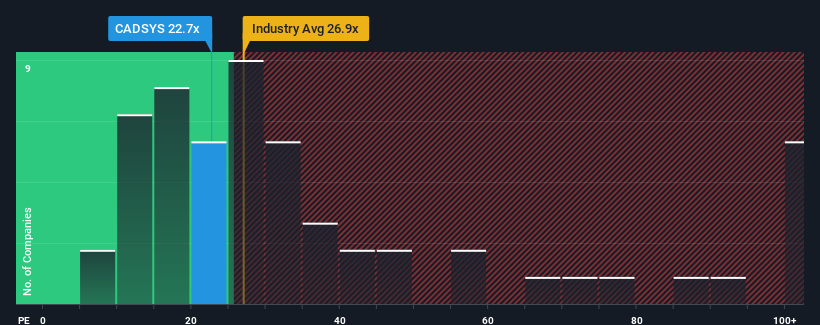- India
- /
- Professional Services
- /
- NSEI:CADSYS
Lacklustre Performance Is Driving Cadsys (India) Limited's (NSE:CADSYS) 40% Price Drop

Cadsys (India) Limited (NSE:CADSYS) shares have retraced a considerable 40% in the last month, reversing a fair amount of their solid recent performance. Nonetheless, the last 30 days have barely left a scratch on the stock's annual performance, which is up a whopping 342%.
After such a large drop in price, Cadsys (India) may be sending bullish signals at the moment with its price-to-earnings (or "P/E") ratio of 22.7x, since almost half of all companies in India have P/E ratios greater than 31x and even P/E's higher than 61x are not unusual. Nonetheless, we'd need to dig a little deeper to determine if there is a rational basis for the reduced P/E.
Cadsys (India) certainly has been doing a great job lately as it's been growing earnings at a really rapid pace. One possibility is that the P/E is low because investors think this strong earnings growth might actually underperform the broader market in the near future. If you like the company, you'd be hoping this isn't the case so that you could potentially pick up some stock while it's out of favour.
See our latest analysis for Cadsys (India)

How Is Cadsys (India)'s Growth Trending?
In order to justify its P/E ratio, Cadsys (India) would need to produce sluggish growth that's trailing the market.
Retrospectively, the last year delivered an exceptional 72% gain to the company's bottom line. Although, its longer-term performance hasn't been as strong with three-year EPS growth being relatively non-existent overall. Therefore, it's fair to say that earnings growth has been inconsistent recently for the company.
Comparing that to the market, which is predicted to deliver 25% growth in the next 12 months, the company's momentum is weaker based on recent medium-term annualised earnings results.
In light of this, it's understandable that Cadsys (India)'s P/E sits below the majority of other companies. It seems most investors are expecting to see the recent limited growth rates continue into the future and are only willing to pay a reduced amount for the stock.
The Bottom Line On Cadsys (India)'s P/E
Cadsys (India)'s recently weak share price has pulled its P/E below most other companies. While the price-to-earnings ratio shouldn't be the defining factor in whether you buy a stock or not, it's quite a capable barometer of earnings expectations.
As we suspected, our examination of Cadsys (India) revealed its three-year earnings trends are contributing to its low P/E, given they look worse than current market expectations. Right now shareholders are accepting the low P/E as they concede future earnings probably won't provide any pleasant surprises. If recent medium-term earnings trends continue, it's hard to see the share price rising strongly in the near future under these circumstances.
You need to take note of risks, for example - Cadsys (India) has 4 warning signs (and 3 which are a bit unpleasant) we think you should know about.
Of course, you might also be able to find a better stock than Cadsys (India). So you may wish to see this free collection of other companies that have reasonable P/E ratios and have grown earnings strongly.
New: AI Stock Screener & Alerts
Our new AI Stock Screener scans the market every day to uncover opportunities.
• Dividend Powerhouses (3%+ Yield)
• Undervalued Small Caps with Insider Buying
• High growth Tech and AI Companies
Or build your own from over 50 metrics.
Have feedback on this article? Concerned about the content? Get in touch with us directly. Alternatively, email editorial-team (at) simplywallst.com.
This article by Simply Wall St is general in nature. We provide commentary based on historical data and analyst forecasts only using an unbiased methodology and our articles are not intended to be financial advice. It does not constitute a recommendation to buy or sell any stock, and does not take account of your objectives, or your financial situation. We aim to bring you long-term focused analysis driven by fundamental data. Note that our analysis may not factor in the latest price-sensitive company announcements or qualitative material. Simply Wall St has no position in any stocks mentioned.
About NSEI:CADSYS
Cadsys (India)
A knowledge process outsourcing company, provides knowledge solutions in India and internationally.
Slightly overvalued with imperfect balance sheet.
Similar Companies
Market Insights
Community Narratives



